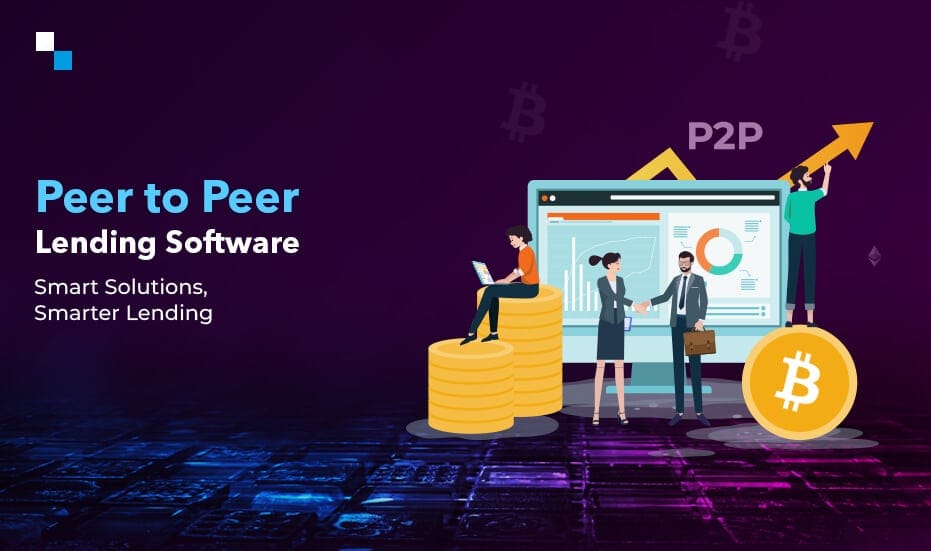In recent years, Peer-to-Peer (P2P) lending has gained significant popularity, revolutionizing the way individuals and businesses borrow and lend money. This innovative financial model eliminates intermediaries like banks and connects borrowers directly with lenders through online platforms. However, as this industry grows, so do the security challenges associated with it. In this article, we will explore the reasons behind the increasing popularity of Peer to Peer Lending Software, the unique security challenges it presents, and strategies to ensure the security of a P2P Lending Platform Software.
Why is Crypto P2P Lending Becoming Popular?
The growth of Peer to Peer Lending Platform Software development has been remarkable in recent years. According to Allied Market Research, Peer-to-peer lending was anticipated to be worth $152.98 billion in 2022 and is projected to rise at a compound annual growth rate (CAGR) of 27.5% from 2023 to $1701.2 billion by 2032. These numbers clearly indicate the increasing popularity and potential of P2P lending as an alternative financial system.
P2P lending offers various advantages that appeal to both borrowers and lenders. For borrowers, P2P lending provides access to funds without the need for a traditional financial institution. This means quicker loan approvals, lower interest rates, and more flexible terms. On the other hand, lenders can earn higher returns by directly investing in borrowers, cutting out intermediaries and their associated fees. The ease and convenience of using Peer to Peer Lending Software have also attracted borrowers who may not have otherwise qualified for loans through traditional channels.
Let’s have a detailed discussion about the reasons behind the growing trend of using Peer to Peer Lending Software to arrange funds in haste:
- Convenient Access to Fund
Peer to Peer Lending Platform Software offers a hassle-free alternative to traditional banking, providing borrowers with quick and easy access to funds. Unlike traditional lenders who often have stringent requirements and lengthy approval processes, P2P lending software leverages innovative technology to expedite loan approvals and disburse funds promptly. - Competitive Interest Rates
By bypassing traditional banks and financial institutions, P2P Lending Platform Software enables lenders to earn attractive returns on their investments. Moreover, borrowers may benefit from competitive interest rates compared to traditional lending options, making P2P lending an appealing choice for both parties involved. - Diversification Opportunities
P2P lending also allows lenders to diversify their investment portfolios. Instead of relying solely on stocks, bonds, or real estate, individuals can allocate a portion of their funds towards P2P lending, spreading their risk across multiple borrowers and reducing their exposure to any single investment.

Security Challenges in P2P Lending
While Peer to Peer Lending Software offers numerous benefits, it also comes with its fair share of security challenges, especially when implemented on blockchain technology. The decentralized nature of the blockchain makes it vulnerable to cyber attacks, including hacking attempts, scams, and unauthorized access to user data. Additionally, the anonymity associated with cryptocurrency transactions raises concerns about money laundering and fraudulent activities. Let’s understand more about security challenges it may raise:
- Identity Verification
One of the key challenges of using a Peer to Peer Lending Platform Software is verifying the identity of borrowers and lenders. This process is crucial to prevent fraudulent activities and ensure that both parties are legitimate. Implementing effective know your customer (KYC) and anti-money laundering (AML) measures becomes paramount to establishing trust and security within the platform. - Data Privacy and Confidentiality
P2P Lending Platform Software handles sensitive personal and financial information, making data privacy and confidentiality a top priority. Robust data encryption, secure data storage, and strict access controls should be implemented to safeguard users’ sensitive data and mitigate the risk of unauthorized access. - Smart Contract Vulnerabilities
P2P lending software often utilizes smart contracts on blockchain networks to automate loan agreements and streamline the lending process. However, these smart contracts are susceptible to coding errors and vulnerabilities. Thorough security audits, code reviews, and continuous monitoring are necessary to minimize the risk of exploitation and ensure the reliability of smart contracts.
Risk Mitigation Strategies For Crypto P2P Lending Software
To ensure the security of crypto P2P lending software, several strategies need to be implemented:
- Robust User Authentication
Implementing two-factor authentication (2FA) and biometric authentication methods, such as fingerprint or facial recognition, adds an extra layer of security to the Peer to Peer Lending Software. This prevents unauthorized access to user accounts and helps to safeguard sensitive information. - Secure Communication Channels
To protect user data during transit, secure communication protocols like HTTPS should be employed. Encryption algorithms such as Transport Layer Security (TLS) or Secure Sockets Layer (SSL) ensure that data exchanged between borrowers, lenders, and the Peer to Peer Lending Platform Software remains confidential and cannot be intercepted or tampered with by malicious entities. - Regular Security Audits
Conducting regular security audits and vulnerability assessments is essential to identify and mitigate potential security risks. This proactive approach allows for the timely detection and remediation of vulnerabilities, ensuring the overall security of the crypto P2P lending software. - Encrypted Data Storage
All sensitive user data should be stored securely using encryption techniques. This protects user information from unauthorized access and safeguards against data breaches. - Continuous Monitoring and Risk Assessment
Regular monitoring and risk assessment of the P2P Lending Platform Software can help identify and mitigate security threats in a timely manner.
Conclusion: How Antier Can Help?
Antier, a renowned blockchain development company, specializes in building secure and robust Peer to Peer Lending Software. With years of experience in the blockchain industry, our team understands the importance of security in decentralized financial ecosystems.
Our experts provide a comprehensive suite of security measures for Peer to Peer Lending Platform Software by leveraging cutting-edge technologies like blockchain and smart contracts, From encrypted user authentication to secure data storage, we ensure that your crypto P2P lending software is fortified against potential threats.
Moreover, Antier brings its expertise in conducting stringent security audits and assessments to identify vulnerabilities and provide effective remediation strategies. Our goal is to create a secure, trustworthy, and seamless experience for both borrowers and lenders in the P2P lending space.
The increasing popularity of P2P Lending Platform Software brings forth unique security challenges that need to be effectively addressed. By implementing strategies to ensure secure crypto P2P lending software, such as robust user authentication, secure communication channels, and regular security audits, the risks can be minimized.
Antier can be your trusted partner in building a secure P2P lending platform, providing the expertise and technology needed to create a safe and reliable ecosystem for borrowers and lenders alike.







